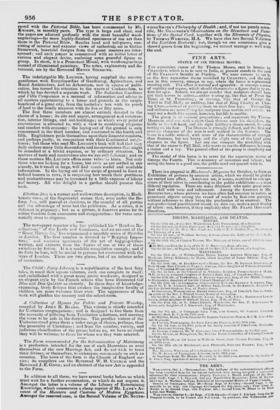FINE ART S.
STATUE OF SIR THOMAS MONRO.
THE equestrian statue of Sir Thomas Monro, cast in bronze by Cnaxsairv, which is to be sent to India, at present stands in the yard of Sir FRAscts.9 foundry at Pimlico. We were curious to see it, as the first equestrian statue modelled by CRANTRE; and the only one in this coonny, strange to say, where the horse is represented standing still. The effect is natural and agreeable: it conveys a sense of stability and repose, which should characterize a figure that is to en- dure for ages. Indeed, we always wonder that sculptors should have put their horses in action,— either rearing up, like that of Peter the Great at St. Petersburg ; or starting, like that of George the Third in Pall Mall; or ambling, like that of King Charles at Char.
ing Cross,—instead of putting them on their four leg:. Tranquillity and stillness are more II:ring for sculpture than motion and acorn: we want not a death-like aspect, however, but life in marble.
The group is of colossal proportions ; and represents Sir Thomas Munro in unif.:rm, with a short cloak thrown over his shoulders, the bridle in his left kslid, and his right holding a drawn sword, its point resting on his foot. The likeness is strongly defined, and the firm and resoh:e character of the man is well marked in the features. The horse is a noble animal, with more of the characteristics of strength than fleetness, but not heavy, and the slight turn of the head gives elegance to the figure. Let any one compare the modelling with that of the statue in Pall Nlall, who wants to see the difference between a statue and a toy. The general effect of the group is simplicity and grandeur.
The model of this horse is to serve for the equestrian statue of George the Fourth. This is economy of invention and labour ; but seeing the horse is a good one, the public need not quarrel with it.


























 Previous page
Previous page